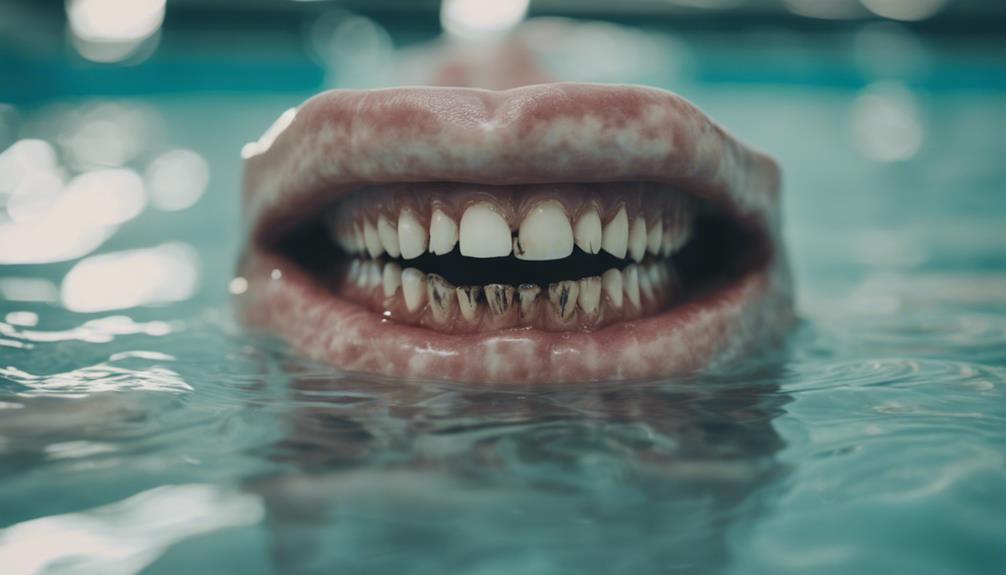To avoid UTIs caused by swimming pools, it is important to maintain good hygiene practices. Before entering the pool, make sure to take a shower to eliminate germs and prevent bacterial growth by not staying in wet swimwear for too long. Remember to urinate before swimming as well. Proper pool hygiene, including regular cleaning and keeping chlorine levels up, is crucial. Drinking plenty of water can help flush out bacteria, and changing out of wet clothes promptly can reduce infection risk. Stay aware of symptoms and follow preventive measures to protect your health. By being aware of the risks and following preventive practices, you can safeguard your well-being. For more information on preventing UTIs from swimming pools, consider using a swimmer’s ear prevention solution before and after swimming to ward off ear infections. It’s also a good idea to avoid poorly maintained pools with cloudy water to lower the risk of UTIs. As summer comes to a close, make sure to prepare your pool for winter by thoroughly cleaning it and adjusting chemical levels to prevent bacteria and algae growth during the offseason. Taking these extra precautions can help ensure a safe and enjoyable swimming experience for all.
Key Takeaways
- Shower before and after swimming to reduce bacteria exposure.
- Change out of wet clothes promptly to prevent UTIs.
- Stay hydrated to flush bacteria from the urinary tract.
- Maintain proper pool hygiene for germ control.
- Avoid sitting in wet bathing suits to minimize infection risks.
Importance of Pool Hygiene
Maintaining proper pool hygiene is essential for preventing infections and UTIs from swimming pools. When individuals enter pool water, they introduce sweat, dirt, and even urine, which can contaminate the pool if not managed correctly. Without adequate hygiene practices, such as regular cleaning and disinfection, germs and bacteria can thrive in the water, increasing the risk of infections like UTIs.
To combat this, monitoring chlorine levels in pools is vital to guarantee effective disinfection and germ control. Additionally, promoting good swimmer etiquette, such as showering before entering the pool, can help prevent contamination.
Risk Factors for UTIs

Swimming in pools, particularly for extended periods or in damp attire, can heighten the risk of contracting urinary tract infections (UTIs). The increased risk of UTIs from swimming pools is attributed to the presence of germs in the water, which can enter the urethra and cause infections.
Prolonged exposure to pool water, especially if you remain in wet bathing suits for long periods, can further elevate the risk. Additionally, failing to empty your bladder before swimming can create a conducive environment for bacterial growth and UTIs.
Individuals with sensitive skin or underlying medical conditions may be more susceptible to UTIs from swimming pools. To mitigate these risks, it's important to practice good hygiene, make sure that pools are properly maintained, and consider taking a shower before and after swimming.
Impact of Chlorine Levels

Proper chlorine levels in swimming pools play a critical role in killing bacteria and preventing infections, such as UTIs.
When chlorine levels aren't adequately maintained, harmful germs can flourish in the water, increasing the risk of illnesses.
Ensuring the right balance of pool chemistry, particularly chlorine levels, is essential for maintaining a safe and hygienic swimming environment.
Chlorine and Bacteria
Sufficient chlorine levels in swimming pools play an essential role in preventing bacterial growth that can lead to UTIs. Chlorine is a powerful disinfectant that helps eliminate harmful bacteria, including those that can cause urinary tract infections. When chlorine levels in pools are too low, bacteria can thrive, increasing the risk of contamination and potential health hazards. Proper chlorine levels are important for effectively killing bacteria and maintaining water quality, thereby reducing the likelihood of UTIs.
Maintaining adequate chlorine levels is important for preventing infections in swimming pools. Inadequate levels of chlorine can result in contaminated water, creating an environment conducive to bacterial growth. Regular monitoring and adjustment of chlorine levels are necessary to ensure a safe swimming environment and minimize the risk of UTIs.
Balancing Pool Chemistry
Maintaining the appropriate balance of chlorine levels in your swimming pool is essential for effectively killing germs and preventing infections. Adequate chlorine levels are vital as they work by breaking down organic material and disinfecting pool water, preventing bacterial growth that could lead to urinary tract infections (UTIs).
Low chlorine levels in pools create an environment where bacteria can thrive, increasing the risk of infections for swimmers. Regularly monitoring and adjusting chlorine levels is necessary to guarantee a safe swimming environment. Imbalanced chlorine levels can result in inadequate disinfection, posing potential health hazards.
To safeguard against UTIs and other infections, it's imperative to uphold the correct chlorine balance in your pool. Remember, proper pool chemistry maintenance not only fosters a clean and healthy swimming environment but also safeguards the well-being of those enjoying the pool.
Hydration and UTI Prevention

Staying well-hydrated is essential for preventing UTIs, especially after swimming in pools. Hydration plays a crucial role in flushing out bacteria from your urinary tract, reducing the risk of UTIs linked to swimming pool exposure. In the summer, when swimming is a popular activity, maintaining adequate hydration levels becomes even more critical to support urinary tract health and fend off infections. Adding fluids like water and cranberry juice, known for their UTI prevention properties, can further boost your body's defense mechanisms against UTIs caused by swimming pool exposure.
| Importance of Hydration for UTI Prevention |
|---|
| Flushes out bacteria from the urinary tract |
| Reduces risk of UTIs after swimming |
| Essential in maintaining urinary tract health |
| Supports the body's defense against infections |
| Cranberry juice can be beneficial for UTI prevention |
Prompt Clothing Changes
Changing out of wet swimwear promptly after swimming is crucial to preventing UTIs, as it helps reduce bacterial growth that thrives in warm, moist environments.
Here are some essential tips to guarantee you stay healthy and UTI-free:
- Avoid Sitting in Wet Bathing Suits: Sitting around in wet swimwear provides an ideal breeding ground for bacteria, increasing the likelihood of UTIs.
- Change Out of Wet Clothes Quickly: Moist places like wet bathing suits are perfect for bacteria to grow, so changing promptly can help prevent infections.
- Use Dry Towels to Pat Dry: Make sure to dry off thoroughly using a clean, dry towel to remove excess moisture and minimize bacterial growth.
- Switch to Dry Clothing: Changing into dry clothes after swimming reduces the risk of UTIs associated with wearing wet garments for extended periods.
Avoiding Holding in Urine
Avoiding holding in urine is vital to decrease the risk of UTIs when swimming in pools. When you resist the urge to urinate, you create an environment where bacteria can multiply in your bladder, increasing the likelihood of a urinary tract infection.
Not emptying your bladder before swimming allows for bacterial growth, potentially leading to infections. Urinating promptly after swimming is essential as it helps flush out bacteria, reducing the risk of UTIs.
Delaying bathroom breaks can contribute greatly to UTIs, especially in warm, moist environments like swimming pools where bacteria thrive. By practicing good bathroom habits and refraining from holding in urine, you can take a proactive step in preventing UTIs associated with swimming pool exposure.
Good Hygiene Practices
To maintain proper hygiene and prevent UTIs from swimming pools, consider incorporating good practices such as showering before entering the pool.
Here are some essential tips for maintaining good hygiene practices:
- Change out of wet swimwear promptly: Wet swimwear creates a breeding ground for bacteria that can lead to urinary tract infections.
- Avoid alcohol consumption in the pool: Alcohol can weaken your immune system, making you more susceptible to infections.
- Empty your bladder before swimming: This simple step can help prevent UTIs by reducing the chances of bacteria entering your urinary tract.
- Carry extra swimwear for regular changes: Having a fresh set of swimwear to change into can help you stay dry and avoid the risks associated with prolonged wet clothing.
UTI Symptoms Awareness
Recognize the signs of a urinary tract infection (UTI) by paying attention to symptoms like pain or burning during urination. Women are four times more likely than men to experience UTIs, making it important to be aware of the warning signs.
If you notice an increase in the frequency of urination, cloudy or bloody urine, back pain, or fever, these could indicate a UTI. Additionally, feeling pressure in the lower belly, experiencing incomplete bladder emptying, or having chills are also symptoms that shouldn't be ignored.
Sitting around in a wet swimsuit or failing to shower after a dip in the pool can increase the risk of developing a UTI. Prompt treatment is essential to prevent complications, such as kidney damage.
Staying Safe in Swimming Pools
To stay safe in swimming pools, follow proper pool hygiene practices:
- Shower before entering the pool
- Refrain from urinating in the water
Be aware of waterborne infection risks, especially in pools frequented by children. Consider using preventive measures like avoiding swallowing pool water.
Remember to change out of wet swimwear promptly after swimming to reduce the risk of infections. Damp clothing can harbor bacteria that may lead to UTIs.
Pool Hygiene Practices
Maintaining proper pool hygiene is essential for ensuring a safe swimming environment and preventing infections. Here are some pool hygiene practices to keep in mind:
- Shower before and after swimming: Washing off sweat, lotions, and other contaminants reduces the risk of skin irritation and helps prevent the spread of germs that can cause infections like urinary tract infections (UTIs).
- Wipe from front to back: Proper hygiene after using the restroom is important, especially for females, as wiping from front to back can help prevent bacteria from entering the urethra and causing UTIs.
- Take hourly breaks: Giving yourself and your children breaks from swimming allows time for the pool's disinfectants to work effectively and reduces the risk of waterborne illnesses.
- Avoid swimming with diarrhea: Diarrhea can introduce harmful pathogens into the pool water, increasing the chances of infections for you and others. Stay out of the pool until symptoms have cleared to prevent contamination and illness.
Waterborne Infection Risks
To safeguard yourself and others against waterborne infection risks in swimming pools, being aware of common pathogens and adopting proper hygiene practices is vital.
During summer, the heat and humidity can increase the risk of waterborne infections like UTIs. Contaminated pool water can harbor bacteria and parasites, leading to illnesses such as diarrhea and respiratory infections.
Over 80% of pool-related illness outbreaks are caused by the parasite Cryptosporidium, emphasizing the significance of maintaining pool hygiene. Individuals wearing bathing suits and sweaty clothes provide a breeding ground for bacteria, increasing the chances of infections.
Skin reactions to chlorine can exacerbate vaginal infections in sensitive individuals. To reduce the risk of waterborne infections, it's essential to shower before entering the pool, promptly change out of wet swimwear, and avoid ingesting pool water.
Preventive Measures Checklist
Ensuring proper hygiene practices and adopting preventive measures are key to staying safe in swimming pools and reducing the risk of infections. To avoid a UTI and other tract infections, follow these simple steps:
- Empty Your Bladder: Before taking a dip, make sure to use the restroom. Holding urine for prolonged periods can promote bacterial growth and increase the chances of infections.
- Change Out of Wet Clothes: After swimming, change out of your bathing suit promptly. Staying in wet bathing suits and sweaty clothes can irritate the skin and create a breeding ground for fungi and bacteria.
- Practice Good Hygiene: Showering before and after swimming can help wash away any potential contaminants on your skin, reducing the risk of infections.
- Don't Reuse Damp Attire: Reusing damp swimsuits can heighten the risk of skin irritation and infections. Always opt for dry clothing to stay comfortable and healthy during pool time.
Frequently Asked Questions
How to Prevent UTI From Swimming Pool?
To prevent UTIs from swimming pools, make sure you empty your bladder before entering the water. Contamination can occur due to urine in the pool, particularly in pools used by children. Properly maintained pools don't directly cause UTIs, but not practicing good hygiene can increase the risk.
Additionally, promptly changing out of wet swimwear after swimming helps reduce the chances of developing UTIs. Stay mindful of these practices to safeguard your health.
How to Prevent Infection From Swimming Pool?
Wondering how to prevent infection from swimming pools?
To minimize risks, always shower before and after swimming to remove germs.
Make sure children take regular bathroom breaks and avoid urinating in the pool.
Change out of wet swimsuits promptly to prevent skin irritation and fungal growth.
Consider wearing a new swimsuit if you have sensitive skin prone to chlorine reactions.
These simple steps can help you enjoy a pool day without worrying about infections.
Do Swimmers Get a Lot of Utis?
Swimmers can be prone to UTIs due to exposure to bacteria in pool water. Prolonged time in wet swimsuits and inadequate hygiene practices contribute to this risk.
By promptly changing out of wet swimwear, emptying your bladder before swimming, and maintaining good bathroom habits, you can reduce the likelihood of UTIs.
These preventative measures are essential for swimmers to minimize the occurrence of urinary tract infections.
How Can I Clean Myself to Prevent Utis?
To prevent UTIs, guarantee proper hygiene by showering before and after swimming. Thoroughly cleanse your body with soap to remove germs.
Avoid swimming if you've had recent diarrhea to prevent spreading contaminants in the pool. Wait at least an hour after recovering from diarrhea before swimming to avoid spreading germs.
Parasites like Cryptosporidium can linger in pools, so steer clear after a stomach bug to safeguard against UTIs.
What Are Other Ways to Prevent UTIs Besides Avoiding Swimming Pools?
In addition to avoiding swimming pools, preventing cruise ship pool accidents can be achieved by staying hydrated, practicing good hygiene, wearing appropriate swimwear, and using the restroom frequently. Taking showers before and after swimming, and not holding in urine can also help prevent UTIs while enjoying pool activities.
Conclusion
To sum up, preventing UTIs from swimming pools requires diligence and awareness of hygiene practices. Just as you wouldn't jump into murky waters without caution, maintaining good pool hygiene is essential to keeping UTIs at bay.
By staying informed and following proper precautions, you can enjoy the pool without worrying about unwanted infections. Remember, a clean pool is like a shield against UTIs, protecting you from unseen dangers lurking beneath the surface.
Stay safe and swim smart!










